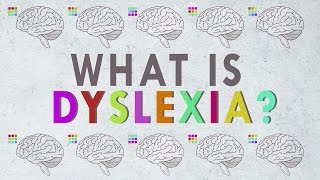(单词翻译:单击)
Take a moment to read the following. How was that?
稍微读一下下面这几行字。怎么样?
Frustrating? Slow? What were those sentences about?
灰心吗?慢吗?那些句子讲的什么?
They're actually a simulation of the experience of dyslexia, designed to make you decode each word.
实际上它们在模拟阅读障碍的感觉,设计它们的目的是让你给每个字解码。
Those with dyslexia experience that laborious pace every time they read.
有阅读障碍的人每次阅读都很费劲。
When most people think of dyslexia, they think of seeing letters and words backwards,
多数人认为阅读障碍就是看到的字母和单词是倒着的,
like seeing "b" as "d" and vice versa, or they might think people with dyslexia see "saw" as "was".
像把b看成d,反之亦然,或者,一般人认为有阅读障碍的人会把saw看成was。
The truth is people with dyslexia see things the same way as everyone else.
事实是有阅读障碍的人看东西的方式和大家一样。
Dyslexia is caused by a phonological processing problem,
阅读障碍是由音韵处理问题所引起的,
meaning people affected by it have trouble not with seeing language but with manipulating it.
意味着受阅读障碍影响的人不是眼睛看语言有问题,而是操纵语言有问题。
For example, if you heard the word cat and then someone asked you, "Remove the 'c'," what word would you have left? At.
例如,如果你听到cat这个单词,接着有人要你去掉c,你还剩哪个单词?At。
This can be difficult for those with dyslexia.
这对有阅读障碍的人来说就难了。
Given a word in isolation, like fantastic, students with dyslexia need to break the word into parts to read it: fan, tas, tic.
假设一个孤立的单词,像fantastic(奇妙的),有阅读障碍的学生需要把这个词拆成几部分来读:fan,tas,tic。
Time spent decoding makes it hard to keep up with peers and gain sufficient comprehension.
译解单词所耗费的时间,使有阅读障碍的人难以向同龄人一样有足够的理解力。
Spelling words phonetically, like s-t-i-k for stick and f-r-e-n-s for friends is also common.
按发音拼单词,像s-t-i-k,拼stick,f-r-e-n-s,拼friends,也很常见。
These difficulties are more widespread and varied than commonly imagined.
这些困难比通常想象得更广泛,更多样化。
Dyslexia affects up to one in five people. It occurs on a continuum.
阅读障碍影响到高达五分之一的人,且连续发生。
One person might have mild dyslexia while the next person has a profound case of it.
一个人可能会有轻度的阅读障碍,而另一个人则阅读障碍很严重。
Dyslexia also runs in families. It's common to see one family member who has trouble spelling
阅读障碍也会遗传的。经常会出现一个家庭成员有拼写障碍,
while another family member has severe difficulty decoding even one syllable words, like catch.
而另一个家庭成员甚至对单音节词也有严重的解码障碍,比如catch。
The continuum and distribution of dyslexia suggests
阅读障碍的连续性和分布表明,
a broader principle to bear in mind as we look at how the brains of those with dyslexia process language.
当我们看有阅读障碍的人的大脑加工语言的方式的时候,要记住一个更广泛的原则。

Neurodiversity is the idea that because all our brains show differences in structure and function,
神经多样化就是这个概念,因为我们的大脑显示出结构和功能的差异,
we shouldn't be so quick to label every deviation from "the norm" as a pathological disorder
我们不应该这么快就给每种偏离“正常”的行为打上病理失调的标签,
or dismiss people living with these variations as "defective."
或把有这些多样化的人当成“有缺陷的人”打发掉。
People with neurobiological variations like dyslexia,
拥有像阅读障碍这样神经变化的人,
including such creative and inventive individuals as Picasso, Muhammad Ali, Whoopi Goldberg, Steven Spielberg, and Cher,
包括这些有创造发明才能的人,比如毕加索,穆罕默德·阿里,乌比戈·德堡,史蒂文·斯皮尔伯格和雪儿
clearly have every capacity to be brilliant and successful in life.
显然他们有能力拥有辉煌和成功的人生。
So, here's the special way the brains of those with dyslexia work. The brain is divided into two hemispheres.
所以,这就是有阅读障碍人的大脑特殊的工作方式。大脑分成两半。
The left hemisphere is generally in charge of language and, ultimately, reading, while the right typically handles spatial activities.
左半脑通常负责语言,最终是阅读,而右边的半脑通常处理空间活动。
fMRI studies have found that the brains of those with dyslexia
功能性磁共振成像研究发现有阅读障碍的人的大脑
rely more on the right hemisphere and frontal lobe than the brains of those without it.
比没有的人的大脑更多地依赖右半脑和额叶。
This means, when they read a word, it takes a longer trip through their brain and can get delayed in the frontal lobe.
这意味着他们在读一个单词时,需要更长的行程经过大脑,并会在额叶延迟。
Because of this neurobiological glitch, they read with more difficulty.
由于神经生物学这个故障,他们在阅读上有更多的困难。
But those with dyslexia can physically change their brain and improve their reading
但患有阅读障碍的人可以改变他们的大脑,提高他们的阅读能力,
with an intensive, multi-sensory intervention that breaks the language down
用集中的多感官的干涉分解语言,
and teaches the reader to decode based on syllable types and spelling rules.
根据音节类型和拼写规则教读者解码。
The brains of those with dyslexia begin using the left hemisphere more efficiently while reading, and their reading improves.
患有阅读障碍的人的大脑,阅读时开始提高左半脑的效率,从而提高他们的阅读能力。
The intervention works because it locates dyslexia appropriately as a functional variation in the brain,
这种治疗起作用的原因在于干扰适当地把阅读障碍定位成大脑功能性的变化,
which, naturally, shows all sorts of variations from one person to another.
这自然显示了人和人之间的各种变化。
Neurodiversity emphasizes this spectrum of brain function in all humans
神经多样性强调的是所有人类中大脑的运作范围
and suggests that to better understand the perspectives of those around us,
以及让我们更了解周遭的人的思考方式,
we should try not only to see the world through their eyes but understand it through their brains.
我们不仅应该试图用他们的眼睛看世界,也要用他们的大脑理解世界。


